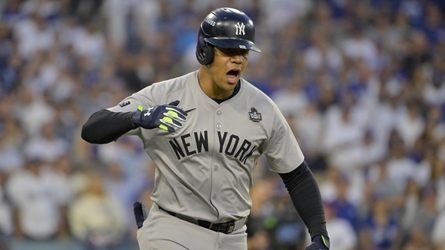The Mets enter this offseason with the expectation that they will be much more aggressive than they were last offseason.
And with New York coming off a magical run to the NLCS and well-positioned payroll-wise to pounce at the top end of the market, the stars seem to be aligning.
While the focus of many fans and other observers will be on the big splash (or two or three) the Mets make, there is tons of other work to be done in David Stearns‘ second offseason at the helm.
Here’s what the Mets’ top five priorities should be…
5. Bolster the bullpen
Stearns arrived in New York with the reputation of being a master builder of bullpens. And even though the Mets’ relief corps was not lockdown in 2024, it was strong enough. Stearns was able to unearth some hidden gems, had a strong deadline while adding needed help, and was quick to make changes when things weren’t working out — as we saw with the decisions to move on from Jorge Lopez and Jake Diekman.
One of the most important things the Mets did under Stearns was give a chance to 28-year-old rookie Dedniel Núñez, who was New York’s best reliever for much of the season. A late-season injury ended his campaign early, but he is expected to be good to go for 2025.
Around Nunez will be closer Edwin Diaz, Reed Garrett, and perhaps Jose Butto — who emerged as a weapon after being moved from the rotation, but had trouble at times recovering from outing to outing while adjusting to his new role.
But there will be lots of change elsewhere.
Ryne Stanek — a key deadline acquisition who emerged in the playoffs — is a free agent. So are Drew Smith (who is recovering from Tommy John surgery) and Adam Ottavino.
Alex Young and Sean Reid-Foley are arbitration-eligible, but an easy case can be made that the Mets should move on.
The Mets also have a decision to make on Phil Maton, a key trade deadline acquisition who was great over the last two months of the season before appearing to tire in the postseason. New York holds a team option on Maton for next season that would pay him $7.75 million.
Looking at the free agent market, there are some intriguing options, including Jeff Hoffman and Tanner Scott.
It’s fair to wonder if the Mets would want to give a big deal to Scott, whose dominance is a recent development. But if they do, pairing the left-handed Scott with the right-handed Diaz would give the Mets one of the best one-two relief punches in the majors.
4. Determine how close the next wave of prospects is
The Mets got an enormous contribution from Mark Vientos in 2024, as he replaced the struggling Brett Baty early in the season and emerged as a potential cornerstone hitter.
Where Vientos will play for the 2025 Mets (third base, first base, designated hitter) remains to be seen, but you can put his name in the lineup in ink.
With Vientos having proven to be a key piece of the future, as the Mets decide how to proceed on the open market this offseason, they need to factor in how close they think their other potential impact young players are.
Two of them — outfielder Drew Gilbert and infielder/outfielder Jett Williams — almost certainly would’ve debuted in 2024 if not for injuries. And both still have something to prove at the highest level of the minors before coming up.
But they should both debut in 2025, giving the Mets two sparkplug-type players who are known for tough at-bats and strong defense.
Then there’s flamethrowing right-hander Brandon Sproat, who will likely start the 2025 season with Triple-A Syracuse, but whose arrival in the majors could happen quickly.
And let’s not forget Ronny Mauricio, who missed the entire 2024 season after tearing his ACL while playing offseason Winter Ball, but who is expected to be back in the mix in 2025.
3. Rebuild the starting rotation
Sean Manaea, Luis Severino, and Jose Quintana are free agents.
That means that following the Mets’ wild postseason run, most of the starting pitchers who carried them through it have uncertain New York futures.
The belief is that the Mets will extend the one-year, qualifying offer to Manaea and that they’ll likely offer it to Severino. Quintana will almost certainly not be receiving the QO.
Manaea, whose midseason delivery change led to him pitching like an ace, will reject the QO. The same can’t be said for Severino if he receives it. But his market should be strong enough to lead to some multiyear offers.
So while the Mets might retain one or more of their pending starting pitching free agents, the possibility exists that none return.
In that scenario, the Mets’ starting pitching depth chart would look something like this:
Kodai Senga
David Peterson
Paul Blackburn
Tylor Megill
Senga and Peterson should be penciled in as members of the rotation, and the arbitration-eligible Blackburn should be solid depth — though his future is a bit uncertain after having a procedure to deal with a spinal leak. Megill remains a bit of an enigma.
As is noted above, Sproat should be an option at some point, but he can’t be counted on from the outset.
Looking at the free agent market, there are aces like Corbin Burnes and Max Fried, and a former ace (Walker Buehler) who could possibly be looking at a one-year deal to rebuild his value — though Buehler’s strong outings in the NLCS and World Series could jack up his market.
2. Make a decision about Pete Alonso
The above might come off as a bit cavalier, since Alonso will be free to sign wherever he wants.
But when you combine the fact that Alonso has been a career Met, his love for the city, his many comments about wanting to stay a Met, and Steve Cohen‘s ability to outbid any team for any player, the equation here seems simple.
That is, if the Mets offer Alonso what he wants, he will return.
Perhaps something weird happens and another team (the Cubs?) wows him and makes him an immediate offer he can’t refuse. But that seems unlikely.
Speaking shortly after the NLCS ended, Stearns discussed Alonso’s future.
“He’s a great Met,” Stearns said. “I hope we have him back. I think we both understand this is a process, and everyone’s got their own interest. And Pete deserves to go out into the free agent market and see what’s out there, and then ultimately make the best choice for him and his family.”
Added Stearns: “How Pete is as a person is important. What he means to this franchise is important. Who he is as a player is also important — what he contributes on the field. There’s no magic formula to this.
“There’s no equation that spits out what all of that is for us. And so there’s judgment involved, there’s evaluating the market involved. And we’ll see how this process goes throughout the offseason.”
It stands to reason that Alonso’s OPS dip over the last three seasons will keep his market in check. And if that turns out to be the case, a reunion with the Mets feels like the most likely outcome.
1. Pursue Juan Soto with reckless abandon
It is usually ill-advised to go completely wild in pursuit of any player. To throw caution to the wind and offer an astronomical amount of years and dollars to someone.
But when you have a chance to secure a generational hitter who is entering his age-26 season, you pull out all the stops — especially when the availability of that hitter on the free agent market syncs up perfectly with your team’s ascendance as a World Series contender.
That’s where the Mets are right now when it comes to Soto, who should be not only their top target this offseason, but the free agent they pursue with more ferocity than any free agent they’ve ever gone after.
Yes, it will not be easy to pry Soto from the Yankees, whose fans will be up in arms if they lose him at all, and who will be apoplectic if they lose him to their crosstown rivals.
At the same time, it’s hard to see any team outbidding the Mets and Cohen for Soto if they do indeed make him their top target.
The question, then, might be how much any team might have to outbid the Yankees to land Soto. The Mets should find out what that number is, and then offer it. If the Yankees match it, they should exceed it. Rinse and repeat.
It can be argued that the Mets are set up better for success going forward than the Yankees. It can also be argued that their clubhouse and overall vibe of fun and looseness might be more welcoming for most players than the sterile, business-like vibe in the Bronx. But this will likely come down to money. And the Mets undoubtedly have the advantage there.
Read the full article here



























Discussion about this post